Energy Solutions that’s what.
http://www.energysolutionsarena.com/
Construction of the EnergySolutions Arena began June 11, 1990 after several months of conceptual design meetings and negotiations with potential lenders. Sumitomo Trust and the Redevelopment Agency of Salt Lake City saw the vision of Larry H. Miller and agreed to fund this new multi-purpose home for the Utah Jazz.
While the “normal” construction period for a project of this type is usually 24 to 30 months, only 15 months and 24 days were available for the completion of the EnergySolutions Arena before the Utah Jazz 1991/92 season opener. This ambitious endeavor was achieved through the cooperation and teamwork of hundreds of individual subcontractors and suppliers and literally thousands of workers both on and off the job site.
Sahara Construction of Bountiful, Utah established a joint venture, O.C./Sahara, with Ohbayashi Corporation for the construction of the 743,000 square foot base building. Sahara also acted as General Contractor for the 7.6 acre pedestrian plaza and the interior tenant improvements within the building. Time constraints required that “fast-track design/build” construction techniques be employed. This method dictates that design is completed as construction is on-going. Responsibility for the structural, mechanical, electrical and civil engineering design was undertaken by the General Contractor. Mechanical and electrical systems were designed and constructed by CCI Mechanical and Western States Electric respectively.
FFKR Architecture/Planning/Interior Design of Salt Lake City worked closely with the construction team to provide design drawings and resolve design issues during the construction process. Based on FFKR’s conceptual design drawings, the General Contractor, with help from its major subcontractors, prepared a guaranteed maximum price contract for the Owner.
Excavation of the 170,000 cubic yards of soil began on an around-the-clock basis as design team members worked feverishly to complete the first design package for the footings and foundations. This process was typical throughout the course of the project as 61 separate bid packages were ultimately prepared.
:}
http://en.wikipedia.org/wiki/EnergySolutions
EnergySolutions
From Wikipedia, the free encyclopedia
Jump to: navigation, search
EnergySolutions is one of the world’s largest processors of low level waste (LLW), and is the largest nuclear waste company in the United States. EnergySolutions is a publicly traded company NYSE: ES) based in Salt Lake City, Utah, although it has operations in 40 states. Steve Creamer is the founder and current CEO of the company, which formed from the merger of four waste disposal companies: Envirocare, Scientech D&D, BNG America, and Duratek. The company took over several Magnox atomic plants from British Nuclear Fuels plc in United Kingdom on June 7, 2007.[1]
EnergySolutions owns and operates a licensed landfill to dispose of radioactive waste in Tooele County, Utah and operates another in Barnwell County, South Carolina. The company also possesses technology to convert waste into environmentally safe forms, such as durable glass, and is contracted by the United States Department of Energy to assist in waste conversion efforts.
The company holds the naming rights to EnergySolutions Arena.
Creation of EnergySolutions
Envirocare of Utah purchased the Connecticut-based Scientech D&D division in October 2005.[2] On February 2, 2006, Envirocare announced the $90 million purchase of BNG America a subsidiary of British Nuclear Fuels (BNFL) based in Virginia.[3] The merged company would change its name to EnergySolutions, with corporate headquarters based in Salt Lake City, Utah. On February 7, 2006, EnergySolutions announced it would buy Maryland-based Duratek, a publicly-traded company, for $396 million in an all-cash deal.[4] The leveraged buyout was financed by banks led by Citigroup, effectively taking the company private.
After the acquisitions, EnergySolutions has 2,500 employees in 40 states with an annual revenue of $280 million.[5] Additionally, EnergySolutions owns two of the nation’s three commercial low-level nuclear-waste repositories, although its primary competitor, Waste Control Specialists, hopes to build a fourth repository in Texas.
Envirocare
Envirocare was founded by Iranian immigrant Khosrow Semnani in 1988. Semnani served as president of the company until May 1997, when Envirocare’s largest customer—the Department of Energy—requested that he step down in the wake of a bribery scandal.[6] Semnani allegedly bribed Utah’s Division of Radiation Control director, Larry B. Anderson, with $600,000 in cash, gifts, and gold coins over several years. Semnani alleged that he was extorted by Anderson, and the two sued each other in civil court. Semnani agreed to testify against Anderson in a plea bargain forcing him to pay a $100,000 fine for aiding in the preparation of a false tax return.[7] Anderson was convicted to serve 30 months in federal prison on tax charges.
In mid-December 2004, Semnani sold Envirocare for an undisclosed sum. Steve Creamer became the company’s new CEO. The deal was financed by private equity firms, led by Lindsay Goldberg & Bessemer of New York, Creamer Investments, and Peterson Partners both of Salt Lake City. Envirocare management promised to drop plans to bury hotter class B and C nuclear waste in Utah in deference to developing political opposition to the company, which was poised to ban the waste anyway.[8] Envirocare’s management and ownership was retained as it made the acquisitions to become EnergySolutions.
Duratek
Based in Columbia, Maryland, Duratek was founded in 1983. In 1990, the company merged with General Technical Services (GTS); the resulting company was known as GTS Duratek[9]. That year, the company formed a joint venture with another firm — Chem-Nuclear Systems, Inc. — to build a commercial vitrification system.
In 1997, GTS Duratek acquired the Scientific Ecology Group (SEG). In 2000, the company purchased the nuclear services business arm of Waste Management Inc.[10] One year later, the company announced that it was dropping GTS from its name, and was once again known as Duratek.
Duratek was purchased by EnergySolutions at 25.7% premium over the February 7, 2006 stock price when the merger was announced.[4]
:}
Aww they are soooo green. Watching the basketball team from New Orleans play in the desert got them to think about the environment. The one thing that the Morman’s believe that God will never allow men to harm.
http://www.energysolutions.com/
OUR COMPANY
EnergySolutions, headquartered in Salt Lake City, Utah, is an international nuclear services company with operations throughout the United States and around the world. With over 5,500 world-class professionals, EnergySolutions is a world leader in the safe recycling, processing and disposal of nuclear material. EnergySolutions provides integrated services and solutions to the nuclear industry, the United States Government, the Government of the United Kingdom, hospitals and research facilities.
With an unparalleled safety record, EnergySolutions has implemented a comprehensive “Safety First” approach that provides safety for our workers, the environment and the communities in which we operate.
EnergySolutions offers a full range of services for the decommissioning and remediation of nuclear sites and facilities, management of spent nuclear fuel, the transportation of nuclear material and the environmental cleanup of nuclear legacy sites such as the uranium mill tailings site in Moab, Utah. We own and operate several state-of-the-art facilities including a metal melt facility in Tennessee and a low-level waste disposal facility in Utah.
EnergySolutions is committed to reasserting America’s leadership in the global nuclear industry and to helping the United States achieve energy security, reduce carbon emissions and protect the environment. As a clean, safe and affordable source of energy, nuclear power plays a vital role in solving the world’s energy crisis and meeting the nation’s growing energy demand.
EnergySolutions, we’re part of the solution.
:}
Wonder if they have been hiring the MAFIA to bury their waste…oh I mean sink boats loaded with their waste at sea? hmmmm
:}






















